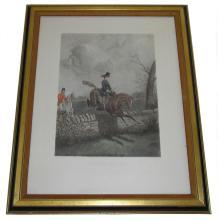SAMUEL WALTERS British Ship Painting
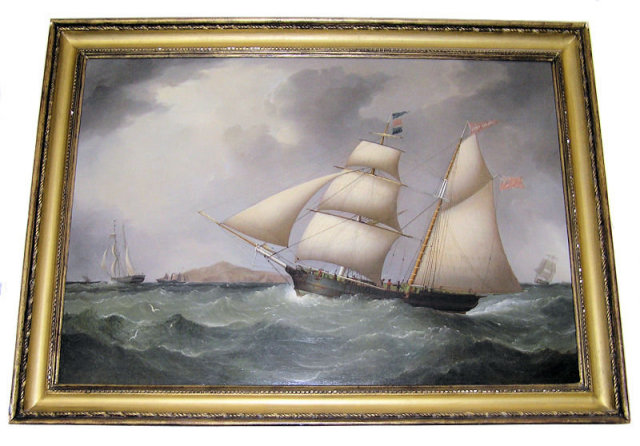
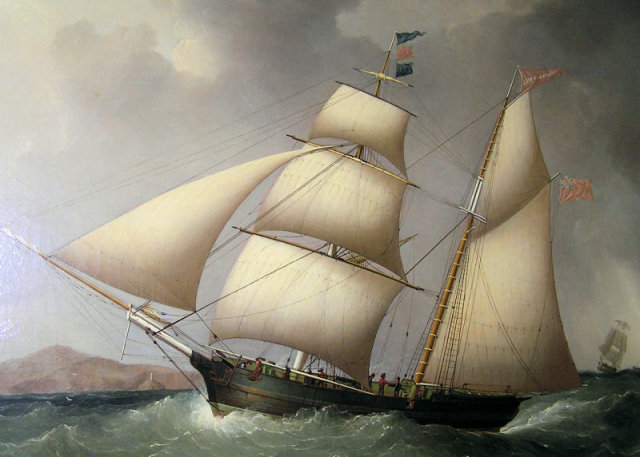
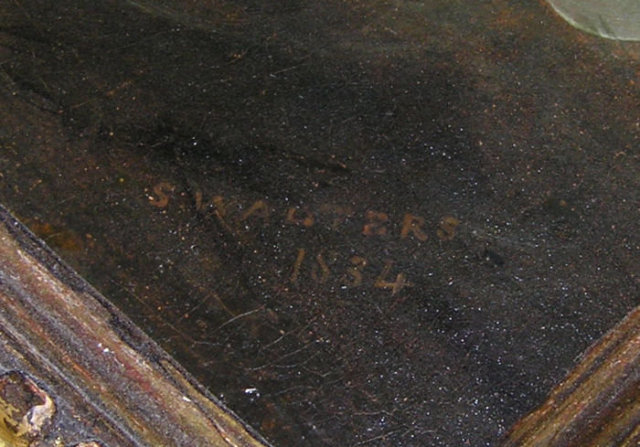
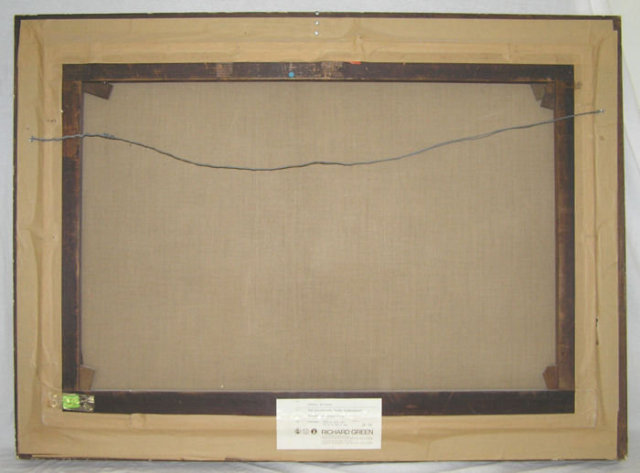
Unavailable
This oil on canvas depicts the English brigantine ship
Lady Combermere, and was painted by
Samuel Walters (1811-1882), the leading Liverpool marine painter of the nineteenth century. This excellent and early work by Walters is signed "S WALTERS" and dated "1834" in the lower right corner. Canvas measures 22.25" by 32.75". Frame measures 37.25" by 27.25 by 2". Provenance:
Richard Green Gallery (147 New Bond Street, London, England, www.richard-green.com); collection of
Roni Steinberg Sokoloff (New York, NY). Original gallery label remains on the rear of the stretcher. This work was appraised by Sotheby's in 1998 for $35,000.
Additional images gladly forwarded upon request.
Samuel Walters was the son of Miles Walters (1773-1855), a master tradesman and marine artist who came from Ilfracombe in North Devon. As a young man Samuel apprenticed in his father's gilding and framing business. Miles and Samuel moved to Liverpool around 1826, and in 1827 they collaborated on their first marine painting, one of approximately forty paintings they worked on together over the next six years until Miles retired as a painter in the mid 1830s. Samuel studied at the Liverpool Mechanics School of Arts and in 1831 he joined the Royal Institution, containing the Liverpool Academy Schools. The previous year he had exhibited his first work at the Academy, entitled Dutch Boats in a Fresh Breeze. This was to be the first of 99 paintings shown at the Academy over the next 35 years. In 1837 he was made an Associate Member. In 1844 he exhibited at the Royal Academy in London, and the following year he resigned from the Academy and moved back to London. He was an admirer of William John Huggins, marine painter to king William IV, and after Huggins died that year, Walters likely aspired to Huggins' position, for he soon took the same of Huggins' at 105 Leadenhall Street where the well known engraver Edward Duncan also worked. In 1847 he returned to Liverpool where he continued to enjoy great success as a marine painter. At this time he was also producing engravings of his originals before turning later to lithographs. Walters had a strong influence on other Liverpool marine artists including Duncan McFarlane, Francis Hustwick, William G.Yorke and his son William H.Yorke. His works are held by most major marine museums throughout the world. (Source: Artnet.com.)
The Artnet database includes 104 paintings by Walters. The most recent auction sale occurred on 7/25/07 at Christie's in New York, when a Walters painting of the American ship Euphrasia off the coast of Liverpool sold for $57,600. The highest known auction sale price for a work by Walters was achieved on 10/28/00 at Skinner in Boston MA, when lot 477, a painting depicting the American clipper Lucy S Wills, sold for $85,000.
This painting comes from the collection of Roni Steinberg Sokoloff and resided in her former 63-acre estate in Bedford New York known as Cantitoe Farms. (It is a short distance from Martha Stewart's estate on Cantitoe Street by the same name.) The painting was purchased by Ms. Sokoloff directly from the Richard Green Gallery in the 1980s.
This British war ship was likely named after the Viscount Combermere, the prominent British military commander Sir Stapleton Cotton (1773-1865), 6th Baronet of Combermere. The term Combermere comes from Comber Mere, the lake which resides in the modern-day Combermere Park in Cheshire England, between Nantwich and Whitchurch, and near the border with Shropshire. Within Combermere Park resides Combermere Abbey, the onetime monastery given to Sir George Cotton, which was expanded by Sir Stapleton Cotton in 1820. The estate remained in the Cotton family until 1919.
Stapleton Cotton was educated at Westminster School and when only sixteen became a second Lieutenant in the 23rd Regiment of Foot. In 1793 he became by purchase Captain in the 6th Dragoon Guards, and he served in this regiment during the campaigns of the Duke of York in Flanders. At the age of 20 he joined the 25th Light Dragoons (subsequently 22nd) as Lieutenant-Colonel and is said to have become a favorite of king George III while serving with his regiment at Weymouth.
In 1796 he went with his regiment to India, taking part en route in the operations in Cape Colony (JulyAugust 1796), and in 1799 served in the war with Tippoo Sahib and at the storming of Seringapatam. Soon afterward he exchanged into a regiment at home, the 16th Light Dragoons. He was stationed in Ireland during Robert Emmet's insurrection, became Colonel in 1800, and Major-General in 1805. From 1806 to 1814 he served as a Member of Parliament for Newark.
In 1808 he was sent to the seat of war in Portugal, where he shortly rose to the position of Commander of Wellington's cavalry. He succeeded to the baronetcy in 1809, but continued his military career. His share in the Battle of Salamanca (July 22, 1812) was especially marked and he received the personal thanks of Wellington. A painting depicting his acceptance of the French defeat is displayed in the library of Combermere Abbey. The day after he was accidentally wounded. He was now a Lieutenant-General in the British army and a K.B. At the conclusion of peace in 1814 he was raised to the peerage under the style of Baron Combermere. When Lord Uxbridge was wounded at Waterloo, Cotton took his command and he remained in France until the reduction of the allied army of occupation. In 1817 he was appointed governor of Barbados and commander of the West Indian forces.
Between 1814 and 1820 he undertook an extensive remodelling of his home, Combermere Abbey, including Gothic ornamentation of the Abbot's House and the construction of Wellington's Wing (now demolished) to mark Wellington's visit to the house in 1820. From 1822 to 1825 he commanded in Ireland. His career of active service was concluded in India in 1826 where he besieged and took Bharatpur, a fort which twenty-two years previously had defied the genius of Lake and was deemed impregnable. For this service he was created Viscount Combermere. A long period of peace and honour still remained to him at home. In 1834 he was sworn a Privy Councillor and in 1852 he succeeded Wellington as Constable of the Tower of London and Lord Lieutenant of the Tower Hamlets. In 1855 he was made a Field-Marshal and G.C.B. He died at Clifton in 1865. An equestrian statue in bronze by Carlo Marochetti was raised in his honour at Chester by the inhabitants of Cheshire. An obelisk was also erected in his memory on the edge of Combermere Park in 1890, under the terms of his widow's will. Combermere was succeeded by his only son, Wellington Henry (18181891), and the viscountcy is still held by his descendants.
Other Keywords: rsok
Additional images gladly forwarded upon request.
Samuel Walters was the son of Miles Walters (1773-1855), a master tradesman and marine artist who came from Ilfracombe in North Devon. As a young man Samuel apprenticed in his father's gilding and framing business. Miles and Samuel moved to Liverpool around 1826, and in 1827 they collaborated on their first marine painting, one of approximately forty paintings they worked on together over the next six years until Miles retired as a painter in the mid 1830s. Samuel studied at the Liverpool Mechanics School of Arts and in 1831 he joined the Royal Institution, containing the Liverpool Academy Schools. The previous year he had exhibited his first work at the Academy, entitled Dutch Boats in a Fresh Breeze. This was to be the first of 99 paintings shown at the Academy over the next 35 years. In 1837 he was made an Associate Member. In 1844 he exhibited at the Royal Academy in London, and the following year he resigned from the Academy and moved back to London. He was an admirer of William John Huggins, marine painter to king William IV, and after Huggins died that year, Walters likely aspired to Huggins' position, for he soon took the same of Huggins' at 105 Leadenhall Street where the well known engraver Edward Duncan also worked. In 1847 he returned to Liverpool where he continued to enjoy great success as a marine painter. At this time he was also producing engravings of his originals before turning later to lithographs. Walters had a strong influence on other Liverpool marine artists including Duncan McFarlane, Francis Hustwick, William G.Yorke and his son William H.Yorke. His works are held by most major marine museums throughout the world. (Source: Artnet.com.)
The Artnet database includes 104 paintings by Walters. The most recent auction sale occurred on 7/25/07 at Christie's in New York, when a Walters painting of the American ship Euphrasia off the coast of Liverpool sold for $57,600. The highest known auction sale price for a work by Walters was achieved on 10/28/00 at Skinner in Boston MA, when lot 477, a painting depicting the American clipper Lucy S Wills, sold for $85,000.
This painting comes from the collection of Roni Steinberg Sokoloff and resided in her former 63-acre estate in Bedford New York known as Cantitoe Farms. (It is a short distance from Martha Stewart's estate on Cantitoe Street by the same name.) The painting was purchased by Ms. Sokoloff directly from the Richard Green Gallery in the 1980s.
This British war ship was likely named after the Viscount Combermere, the prominent British military commander Sir Stapleton Cotton (1773-1865), 6th Baronet of Combermere. The term Combermere comes from Comber Mere, the lake which resides in the modern-day Combermere Park in Cheshire England, between Nantwich and Whitchurch, and near the border with Shropshire. Within Combermere Park resides Combermere Abbey, the onetime monastery given to Sir George Cotton, which was expanded by Sir Stapleton Cotton in 1820. The estate remained in the Cotton family until 1919.
Stapleton Cotton was educated at Westminster School and when only sixteen became a second Lieutenant in the 23rd Regiment of Foot. In 1793 he became by purchase Captain in the 6th Dragoon Guards, and he served in this regiment during the campaigns of the Duke of York in Flanders. At the age of 20 he joined the 25th Light Dragoons (subsequently 22nd) as Lieutenant-Colonel and is said to have become a favorite of king George III while serving with his regiment at Weymouth.
In 1796 he went with his regiment to India, taking part en route in the operations in Cape Colony (JulyAugust 1796), and in 1799 served in the war with Tippoo Sahib and at the storming of Seringapatam. Soon afterward he exchanged into a regiment at home, the 16th Light Dragoons. He was stationed in Ireland during Robert Emmet's insurrection, became Colonel in 1800, and Major-General in 1805. From 1806 to 1814 he served as a Member of Parliament for Newark.
In 1808 he was sent to the seat of war in Portugal, where he shortly rose to the position of Commander of Wellington's cavalry. He succeeded to the baronetcy in 1809, but continued his military career. His share in the Battle of Salamanca (July 22, 1812) was especially marked and he received the personal thanks of Wellington. A painting depicting his acceptance of the French defeat is displayed in the library of Combermere Abbey. The day after he was accidentally wounded. He was now a Lieutenant-General in the British army and a K.B. At the conclusion of peace in 1814 he was raised to the peerage under the style of Baron Combermere. When Lord Uxbridge was wounded at Waterloo, Cotton took his command and he remained in France until the reduction of the allied army of occupation. In 1817 he was appointed governor of Barbados and commander of the West Indian forces.
Between 1814 and 1820 he undertook an extensive remodelling of his home, Combermere Abbey, including Gothic ornamentation of the Abbot's House and the construction of Wellington's Wing (now demolished) to mark Wellington's visit to the house in 1820. From 1822 to 1825 he commanded in Ireland. His career of active service was concluded in India in 1826 where he besieged and took Bharatpur, a fort which twenty-two years previously had defied the genius of Lake and was deemed impregnable. For this service he was created Viscount Combermere. A long period of peace and honour still remained to him at home. In 1834 he was sworn a Privy Councillor and in 1852 he succeeded Wellington as Constable of the Tower of London and Lord Lieutenant of the Tower Hamlets. In 1855 he was made a Field-Marshal and G.C.B. He died at Clifton in 1865. An equestrian statue in bronze by Carlo Marochetti was raised in his honour at Chester by the inhabitants of Cheshire. An obelisk was also erected in his memory on the edge of Combermere Park in 1890, under the terms of his widow's will. Combermere was succeeded by his only son, Wellington Henry (18181891), and the viscountcy is still held by his descendants.
Other Keywords: rsok
Vintage Views
West New York, New Jersey
Dealer accepts: PayPal, Cash, Check
Shipping: Negotiated with Seller




